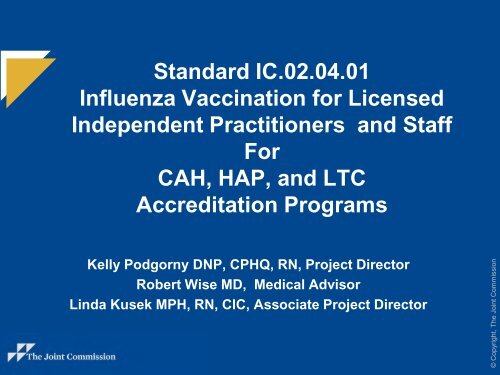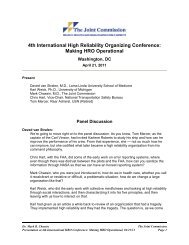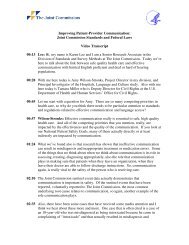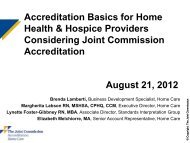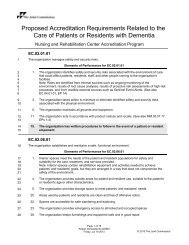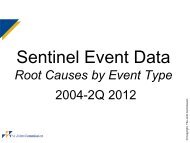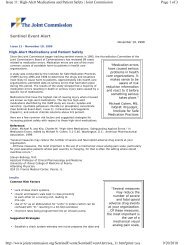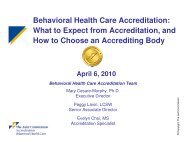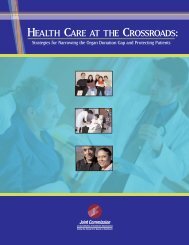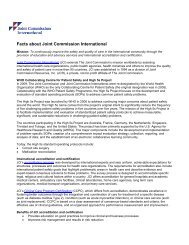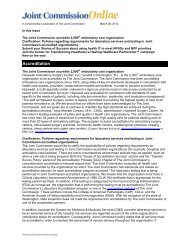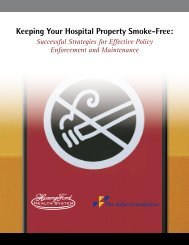Standard IC.02.04.01 - Joint Commission
Standard IC.02.04.01 - Joint Commission
Standard IC.02.04.01 - Joint Commission
Create successful ePaper yourself
Turn your PDF publications into a flip-book with our unique Google optimized e-Paper software.
<strong>Standard</strong> <strong>IC.02.04.01</strong><br />
Influenza Vaccination for Licensed<br />
Independent Practitioners and Staff<br />
For<br />
CAH, HAP, and LTC<br />
Accreditation Programs<br />
Kelly Podgorny DNP, CPHQ, RN, Project Director<br />
Robert Wise MD, Medical Advisor<br />
Linda Kusek MPH, RN, CIC, Associate Project Director<br />
© Copyright, The <strong>Joint</strong> <strong>Commission</strong>
<strong>Standard</strong> <strong>IC.02.04.01</strong><br />
The <strong>Joint</strong> <strong>Commission</strong> approved revised<br />
<strong>Standard</strong> <strong>IC.02.04.01</strong>, influenza<br />
vaccination for licensed independent<br />
practitioners and staff for all<br />
accreditation programs, in September<br />
2011.<br />
2<br />
© Copyright, The <strong>Joint</strong> <strong>Commission</strong>
<strong>Standard</strong> <strong>IC.02.04.01</strong><br />
Focus of today’s presentation includes<br />
the applicability of <strong>Standard</strong> <strong>IC.02.04.01</strong> to<br />
the following accreditation programs:<br />
– Critical Access Hospitals (CAH)<br />
– Hospitals (HAP)<br />
– Long Term Care (LTC)<br />
3<br />
© Copyright, The <strong>Joint</strong> <strong>Commission</strong>
Objectives: Participants will be<br />
knowledgeable about:<br />
<strong>Standard</strong> <strong>IC.02.04.01</strong><br />
– The rationale for revising <strong>Standard</strong><br />
<strong>IC.02.04.01</strong> for CAH, HAP and LTC.<br />
– The specific requirements of <strong>Standard</strong><br />
<strong>IC.02.04.01</strong> including the nine EPs.<br />
4<br />
© Copyright, The <strong>Joint</strong> <strong>Commission</strong>
<strong>Standard</strong> <strong>IC.02.04.01</strong><br />
Outline for this presentation:<br />
1. Rationale for <strong>Standard</strong> <strong>IC.02.04.01</strong>.<br />
2. The <strong>Joint</strong> <strong>Commission</strong>’s actions<br />
3. Concerns about mandating and paying for the<br />
influenza vaccination for staff and licensed<br />
independent practitioners<br />
4. Review of <strong>Standard</strong> <strong>IC.02.04.01</strong> and the nine<br />
elements of performance (EPs)<br />
5. Influenza Vaccination Myths and Realities<br />
6. Resources<br />
7. Contacts<br />
8. References<br />
5<br />
© Copyright, The <strong>Joint</strong> <strong>Commission</strong>
<strong>Standard</strong> <strong>IC.02.04.01</strong><br />
Rationale for <strong>Standard</strong> <strong>IC.02.04.01</strong>:<br />
– In 2010, the Department of Health and Human Services (HHS)<br />
issued the HHS Action Plan to Prevent Healthcare-Associated<br />
Infections: Influenza Vaccination of Healthcare Personnel. This<br />
draft action plan states:<br />
“Influenza transmission to patients by healthcare personnel (HCP) is well<br />
documented. HCP can acquire and transmit influenza from patients or<br />
transmit influenza to patients and other staff. Vaccination remains the<br />
single most effective preventive measure available against influenza<br />
and can prevent many illnesses, deaths, and losses in productivity.<br />
Despite the documented benefits of HCP influenza vaccination on patient<br />
outcomes, HCP absenteeism, and on reducing influenza infection among<br />
staff, vaccination coverage among HCP has remained well below the<br />
national 2010 health objective of 60%.” 1<br />
6<br />
© Copyright, The <strong>Joint</strong> <strong>Commission</strong>
<strong>Standard</strong> <strong>IC.02.04.01</strong><br />
Rationale for <strong>Standard</strong> <strong>IC.02.04.01</strong>:<br />
– Professional/scientific organizations<br />
recommend the influenza vaccination for all<br />
staff in healthcare including:<br />
APIC<br />
CDC<br />
IDSA<br />
NFID<br />
SHEA<br />
―Science clearly supports influenza<br />
vaccination for healthcare personnel<br />
7<br />
© Copyright, The <strong>Joint</strong> <strong>Commission</strong>
<strong>Standard</strong> <strong>IC.02.04.01</strong><br />
<strong>Joint</strong> <strong>Commission</strong> Actions:<br />
– Revised <strong>Standard</strong> <strong>IC.02.04.01</strong> for critical access<br />
hospitals, hospitals, and long term care.<br />
Strengthened the requirements<br />
Aligned the requirements with the HHS Action<br />
Plan<br />
– Conducted a field review for all accreditation<br />
programs from April 5, 2011 through May 17, 2011.<br />
– Board of <strong>Commission</strong>ers approved <strong>Standard</strong><br />
<strong>IC.02.04.01</strong> on September 21, 2011.<br />
8<br />
© Copyright, The <strong>Joint</strong> <strong>Commission</strong>
<strong>Standard</strong> <strong>IC.02.04.01</strong><br />
Providing Influenza Vaccination<br />
Percentage of respondents that indicated their organization has offered<br />
influenza vaccination for 5 or more years, by program.<br />
n=1,630<br />
Hospital/Critical Access Hospital (n=873)<br />
Long Term Care (n=38)<br />
Ambulatory/Office-Based Surgery (n=287)<br />
Behavioral Health Care (n=143)<br />
Laboratory (n=65)<br />
Home Care (n=187)<br />
0% 10% 20% 30% 40% 50% 60% 70% 80% 90% 100%<br />
9<br />
© Copyright, The <strong>Joint</strong> <strong>Commission</strong>
<strong>Standard</strong> <strong>IC.02.04.01</strong><br />
Measuring Influenza Vaccination Rates<br />
Percentage of respondents that indicated their organization has<br />
measured influenza vaccination rates for 5 or more years, by program.<br />
n=1,386<br />
Hospital/Critical Access Hospital (n=841)<br />
Long Term Care (n=37)<br />
Ambulatory/Office-Based Surgery (n=236)<br />
Behavioral Health Care (n=115)<br />
Laboratory (n=46)<br />
Home Care (n=111)<br />
0% 10% 20% 30% 40% 50% 60% 70% 80% 90% 100%<br />
10<br />
© Copyright, The <strong>Joint</strong> <strong>Commission</strong>
<strong>Standard</strong> <strong>IC.02.04.01</strong><br />
Confusion about <strong>Standard</strong> <strong>IC.02.04.01</strong>,<br />
mandating the influenza vaccination for<br />
licensed independent practitioners and staff.<br />
<strong>Standard</strong> <strong>IC.02.04.01</strong> does not mandate<br />
influenza vaccination for licensed<br />
independent practitioners and staff as a<br />
condition of <strong>Joint</strong> <strong>Commission</strong> accreditation.<br />
11<br />
© Copyright, The <strong>Joint</strong> <strong>Commission</strong>
<strong>Standard</strong> <strong>IC.02.04.01</strong><br />
Payment for the influenza vaccination:<br />
– The <strong>Joint</strong> <strong>Commission</strong> does not require<br />
accredited organizations to pay for the<br />
influenza vaccination for licensed<br />
independent practitioners and staff.<br />
12<br />
© Copyright, The <strong>Joint</strong> <strong>Commission</strong>
Introduction to <strong>Standard</strong> <strong>IC.02.04.01</strong><br />
Influenza Vaccination for Licensed<br />
Independent Practitioners and Staff<br />
and<br />
The Elements of Performance (EP)<br />
13<br />
© Copyright, The <strong>Joint</strong> <strong>Commission</strong>
<strong>Standard</strong> <strong>IC.02.04.01</strong><br />
The goal of <strong>Standard</strong> <strong>IC.02.04.01</strong> is for<br />
organizations to:<br />
– Establish an influenza vaccination program<br />
for staff and licensed independent<br />
practitioners.<br />
– Set incremental goals for meeting the 90%<br />
target in 2020.<br />
– Measure and improve influenza vaccination<br />
rates for staff and licensed independent<br />
practitioners.<br />
14<br />
© Copyright, The <strong>Joint</strong> <strong>Commission</strong>
<strong>Standard</strong> <strong>IC.02.04.01</strong><br />
The requirements for revised <strong>Standard</strong><br />
<strong>IC.02.04.01</strong> are comparable across<br />
accreditation programs. However,<br />
– The language can vary by accreditation<br />
program/setting.<br />
– When an organization is accredited under more than<br />
one accreditation program, it is important that<br />
<strong>Standard</strong> <strong>IC.02.04.01</strong> be reviewed for each program.<br />
15<br />
© Copyright, The <strong>Joint</strong> <strong>Commission</strong>
<strong>Standard</strong> <strong>IC.02.04.01</strong>:<br />
<strong>Standard</strong> <strong>IC.02.04.01</strong><br />
– <strong>Standard</strong>: The organization offers vaccination<br />
against influenza to licensed independent<br />
practitioners and staff.<br />
– Note: This standard is applicable to staff and<br />
licensed independent practitioners only when care,<br />
treatment, or services are provided on-site. When<br />
care, treatment, or services are provided off-site,<br />
such as with telemedicine or telephone<br />
consultation, this standard is not applicable to offsite<br />
staff and licensed independent practitioners.<br />
16<br />
© Copyright, The <strong>Joint</strong> <strong>Commission</strong>
<strong>Standard</strong> <strong>IC.02.04.01</strong><br />
Element of Performance (EP) 1:<br />
– The organization establishes an annual influenza<br />
vaccination program that is offered to licensed<br />
independent practitioners and staff.<br />
– No documentation required<br />
– Scoring: A (exists or does not exist)<br />
– Implementation: July 1, 2012<br />
17<br />
© Copyright, The <strong>Joint</strong> <strong>Commission</strong>
<strong>Standard</strong> <strong>IC.02.04.01</strong><br />
EP 2:<br />
– The organization educates licensed independent<br />
practitioners and staff about, at a minimum, the influenza<br />
vaccine; non-vaccine control and prevention measures;<br />
and the diagnosis, transmission, and impact of influenza.<br />
(See also HR.01.04.01, EP 4)<br />
– No documentation required<br />
– Scoring: C (frequency based scoring)<br />
– Implementation: July 1, 2012<br />
18<br />
© Copyright, The <strong>Joint</strong> <strong>Commission</strong>
<strong>Standard</strong> <strong>IC.02.04.01</strong><br />
EP 3: Language differences by program:<br />
– CAH, HAP, and LTC: The organization provides<br />
influenza vaccination at sites and times accessible to<br />
licensed independent practitioners and staff.<br />
– AHC, BHC, and OBS only: The organization offers<br />
the influenza vaccination on-site to licensed<br />
independent practitioners and staff or facilitates their<br />
obtaining the influenza vaccination off-site.<br />
19<br />
© Copyright, The <strong>Joint</strong> <strong>Commission</strong>
<strong>Standard</strong> <strong>IC.02.04.01</strong><br />
EP 3:<br />
– No documentation required<br />
– Scoring: A (exists or does not exist)<br />
– Implementation: July 1, 2012<br />
20<br />
© Copyright, The <strong>Joint</strong> <strong>Commission</strong>
EP 4:<br />
<strong>Standard</strong> <strong>IC.02.04.01</strong><br />
– The organization includes in its infection<br />
control plan the goal of improving influenza<br />
vaccination rates. (For more information,<br />
refer to <strong>Standard</strong> IC.01.04.01)<br />
– Documentation required<br />
– Scoring: A (exists or does not exist)<br />
– Implementation: July 1, 2012<br />
21<br />
© Copyright, The <strong>Joint</strong> <strong>Commission</strong>
<strong>Standard</strong> <strong>IC.02.04.01</strong><br />
EP 5:<br />
– The organization sets incremental influenza<br />
vaccination goals, consistent with achieving the<br />
90% rate established in the national influenza<br />
initiatives for 2020.<br />
– Note: The U.S. Department of Health and Human<br />
Services' Action Plan to Prevent Healthcare-<br />
Associated Infections is located at:<br />
http://www.hhs.gov/ash/initiatives/hai/tier2_flu<br />
.html.<br />
22<br />
© Copyright, The <strong>Joint</strong> <strong>Commission</strong>
<strong>Standard</strong> <strong>IC.02.04.01</strong><br />
EP 5:<br />
– Documentation required<br />
– Scoring: A (exists or does not exist)<br />
– Implementation: July 1, 2012<br />
23<br />
© Copyright, The <strong>Joint</strong> <strong>Commission</strong>
<strong>Standard</strong> <strong>IC.02.04.01</strong><br />
EP 5: Examples of meeting the intent and<br />
not meeting the intent of <strong>Standard</strong><br />
<strong>IC.02.04.01</strong>:<br />
– Meeting the intent: Organization A has a current<br />
influenza vaccination rate of 50% and sets the following<br />
goals: –2012: 60%<br />
– 2014: 75%<br />
– 2016: 85%<br />
– Not meeting the intent: Organization B has a current<br />
influenza vaccination rate of 50% and sets the following<br />
goals: – 2012: 52%<br />
– 2014: 54%<br />
– 2016: 55%<br />
24<br />
© Copyright, The <strong>Joint</strong> <strong>Commission</strong>
EP 6:<br />
<strong>Standard</strong> <strong>IC.02.04.01</strong><br />
– The organization has a written description of the<br />
methodology used to determine influenza vaccination<br />
rates. (See <strong>IC.02.04.01</strong>, EP 1)<br />
– Note: The National Quality Forum (NQF) Measure<br />
Submission and Evaluation Worksheet 5.0 provides<br />
recommendations for the numerator and denominator<br />
on the performance measure for NQF #0431<br />
INFLUENZA VACCINATION COVERAGE AMONG<br />
HEALTHCARE PERSONNEL.<br />
– See:<br />
http://www.qualityforum.org/WorkArea/linkit.aspx?LinkIdentifier=id&ItemID=68275<br />
25<br />
© Copyright, The <strong>Joint</strong> <strong>Commission</strong>
<strong>Standard</strong> <strong>IC.02.04.01</strong><br />
EP 6 Note Continued: The <strong>Joint</strong> <strong>Commission</strong><br />
recommends that organizations use the Centers for<br />
Disease Control and Prevention (CDC) and the National<br />
Quality Forum (NQF) proposed performance measure to<br />
calculate the influenza vaccination rate for staff and<br />
licensed independent practitioners.<br />
– The most researched methodology for calculating the<br />
influenza vaccination rate for healthcare personnel<br />
available.<br />
– Clearly delineates numerator and denominator.<br />
– The CDC reported to The <strong>Joint</strong> <strong>Commission</strong> that the<br />
measure can be used in all healthcare settings even<br />
though it was not tested in all healthcare settings.<br />
26<br />
© Copyright, The <strong>Joint</strong> <strong>Commission</strong>
<strong>Standard</strong> <strong>IC.02.04.01</strong><br />
EP 6 Note Continued:<br />
– The CDC/NQF measure, however, does<br />
not include all contracted staff.<br />
CDC reported that the data are very<br />
difficult to obtain.<br />
Inaccurate and unreliable data could<br />
inadvertently alter the influenza<br />
vaccination rate.<br />
Altered influenza vaccination rate could<br />
impact some organizations financially in<br />
the future because of required reporting.<br />
27<br />
© Copyright, The <strong>Joint</strong> <strong>Commission</strong>
<strong>Standard</strong> <strong>IC.02.04.01</strong><br />
EP 6 -The <strong>Joint</strong> <strong>Commission</strong>’s Position:<br />
– The influenza vaccination is to be offered to all<br />
contracted staff even though not all are to be<br />
included in the measurement rate.<br />
– The <strong>Joint</strong> <strong>Commission</strong> recommends that influenza<br />
vaccination rates for contracted staff be tracked<br />
separately by the organization.<br />
– The tracked information on contract staff can be<br />
used as part of determining improvement for<br />
<strong>IC.02.04.01</strong> EP 8.<br />
28<br />
© Copyright, The <strong>Joint</strong> <strong>Commission</strong>
<strong>Standard</strong> <strong>IC.02.04.01</strong><br />
EP 6 Note Continued:<br />
– The <strong>Joint</strong> <strong>Commission</strong> recommends that<br />
organizations also track influenza<br />
vaccination rates for all individuals<br />
providing care, treatment, and services<br />
through a contract, since contracted<br />
individuals also transmit influenza.<br />
29<br />
© Copyright, The <strong>Joint</strong> <strong>Commission</strong>
<strong>Standard</strong> <strong>IC.02.04.01</strong><br />
EP 6:<br />
– Documentation required<br />
– Scoring: A (exists or does not exist)<br />
– Implementation: July 1, 2012<br />
30<br />
© Copyright, The <strong>Joint</strong> <strong>Commission</strong>
EP 7:<br />
<strong>Standard</strong> <strong>IC.02.04.01</strong><br />
– The organization collects and reviews the<br />
reasons given by staff and licensed<br />
independent practitioners for declining the<br />
influenza vaccination. This collection and<br />
review occurs at least annually.<br />
– This EP does not require that a declination<br />
form be signed.<br />
31<br />
© Copyright, The <strong>Joint</strong> <strong>Commission</strong>
<strong>Standard</strong> <strong>IC.02.04.01</strong><br />
EP 7:<br />
– No documentation required<br />
– Scoring: A (exists or does not exist)<br />
– Implementation: July 1, 2012<br />
32<br />
© Copyright, The <strong>Joint</strong> <strong>Commission</strong>
<strong>Standard</strong> <strong>IC.02.04.01</strong><br />
EP 8:<br />
– The organization improves its vaccination rates<br />
according to its established, internal goals at least<br />
annually. (For more information, refer to <strong>Standard</strong>s<br />
PI.02.01.01 and PI.03.01.01)<br />
33<br />
© Copyright, The <strong>Joint</strong> <strong>Commission</strong>
<strong>Standard</strong> <strong>IC.02.04.01</strong><br />
EP 8:<br />
– Documentation required<br />
– Scoring: A (exists or does not exist)<br />
– Implementation: July 1, 2012<br />
34<br />
© Copyright, The <strong>Joint</strong> <strong>Commission</strong>
<strong>Standard</strong> <strong>IC.02.04.01</strong><br />
EP 9: Language differences by program:<br />
CAH, HAP, LTC: The organization provides influenza<br />
vaccination rate data to key stakeholders which may<br />
include leaders, licensed independent practitioners,<br />
nursing staff, and other staff at least annually.<br />
AHC, BHC, OBS: The organization provides<br />
influenza vaccination rate data to organizational<br />
leaders at least annually.<br />
35<br />
© Copyright, The <strong>Joint</strong> <strong>Commission</strong>
<strong>Standard</strong> <strong>IC.02.04.01</strong><br />
EP 9:<br />
– No documentation required<br />
– Scoring: A (exists or does not exist)<br />
– Implementation: July 1, 2012<br />
36<br />
© Copyright, The <strong>Joint</strong> <strong>Commission</strong>
Implementation differences by<br />
accreditation program:<br />
<strong>Standard</strong> <strong>IC.02.04.01</strong><br />
– For CAH, HAP and LTC:<br />
All elements of performance will go into effect<br />
in July 1, 2012.<br />
– There is a phased-approach for implementation of<br />
<strong>Standard</strong> <strong>IC.02.04.01</strong> for other accreditation<br />
programs such as AHC and OME.<br />
The phased approach for implementation for<br />
<strong>Standard</strong> <strong>IC.02.04.01</strong> is not applicable to CAH,<br />
HAP, and LTC.<br />
37<br />
© Copyright, The <strong>Joint</strong> <strong>Commission</strong>
Influenza Vaccination<br />
Myths and Realities<br />
38<br />
© Copyright, The <strong>Joint</strong> <strong>Commission</strong>
<strong>Standard</strong> <strong>IC.02.04.01</strong><br />
Influenza Vaccination Myths and Realities:<br />
Myth<br />
1. The flu vaccine can cause<br />
influenza.<br />
Reality<br />
The injectable flu vaccine does not<br />
contain the live virus so it is impossible<br />
to get influenza from the vaccine.<br />
The nasal spray flu vaccine contains<br />
live, attenuated (weakened) viruses that<br />
can cause mild signs or symptoms.<br />
2. The flu shot doesn’t work. The influenza vaccine will prevent<br />
influenza most of the time. In scientific<br />
studies, the effectiveness of the vaccine<br />
ranges from 70 to 90 percent, depending<br />
on how well the circulating viruses<br />
match those in the vaccine.<br />
3. Our staff follows <strong>Standard</strong><br />
Precautions, with good<br />
hand hygiene practices<br />
and appropriate glove and<br />
mask use.<br />
Influenza is spread by respiratory<br />
droplets generated when talking,<br />
coughing or sneezing. Adults shed<br />
influenza virus at least one day before<br />
any signs or symptoms of the disease.<br />
39<br />
© Copyright, The <strong>Joint</strong> <strong>Commission</strong>
<strong>Standard</strong> <strong>IC.02.04.01</strong><br />
Influenza Vaccination Myths and Realities:<br />
Myth<br />
4. Our staff stays at home if<br />
they are sick - so<br />
vaccination is not<br />
necessary.<br />
5. There is no evidence to<br />
support that influenza<br />
vaccination of staff<br />
improves patient<br />
outcomes.<br />
6. Influenza vaccinations for<br />
staff will be too costly.<br />
Reality<br />
Since unvaccinated individuals are<br />
contagious at least one day before any<br />
signs or symptoms of influenza appear,<br />
they can still shed the virus and infect<br />
patients and other staff.<br />
Influenza transmission and outbreaks in<br />
health care organizations have been<br />
recognized for many years and have been<br />
associated with substantial morbidity,<br />
mortality, and costs.<br />
The cost savings associated with health<br />
care personnel influenza vaccination<br />
programs generally outweigh the costs<br />
associated with providing the vaccine,<br />
and vaccinating ultimately results in a<br />
safer environment for patients.<br />
40<br />
© Copyright, The <strong>Joint</strong> <strong>Commission</strong>
Resources:<br />
<strong>Standard</strong> <strong>IC.02.04.01</strong><br />
– Influenza and Influenza Vaccine Myths and<br />
Reality<br />
– An educational document prepared by The <strong>Joint</strong><br />
<strong>Commission</strong><br />
– Please use during your educational efforts<br />
– Available with today’s hands out. Will also be<br />
available on the infection prevention website<br />
41<br />
© Copyright, The <strong>Joint</strong> <strong>Commission</strong>
<strong>Standard</strong> <strong>IC.02.04.01</strong><br />
Resources:<br />
– Influenza Vaccination Monograph at:<br />
– http://www.jointcommission.org/Providing_a_Safer_Environment/<br />
42<br />
© Copyright, The <strong>Joint</strong> <strong>Commission</strong>
<strong>Standard</strong> <strong>IC.02.04.01</strong><br />
Resources-<strong>Joint</strong> <strong>Commission</strong> Resources:<br />
The Flu Vaccination Challenge<br />
43<br />
© Copyright, The <strong>Joint</strong> <strong>Commission</strong>
<strong>Standard</strong> <strong>IC.02.04.01</strong><br />
Resources:<br />
– <strong>Joint</strong> <strong>Commission</strong> Resources: The Flu<br />
Vaccination Challenge<br />
– Available at: http://www.jcrinc.com/fluchallenge/<br />
– Purpose: To continue increasing flu vaccination<br />
rates among health care workers, since flu<br />
vaccination for health care workers is important<br />
not only to help protect themselves, but also to<br />
reduce the risk of flu infection for patients or the<br />
individuals served.<br />
– Many resources on its website<br />
44<br />
© Copyright, The <strong>Joint</strong> <strong>Commission</strong>
<strong>Standard</strong> <strong>IC.02.04.01</strong><br />
Contacts:<br />
– The <strong>Joint</strong> <strong>Commission</strong>’s <strong>Standard</strong>s<br />
Interpretation Group through its online<br />
question form at:<br />
– http://www.jointcommission.org/<strong>Standard</strong>s/.<br />
– Kelly Podgorny DNP, RN, CPHQ<br />
Kpodgorny@jointcommission.org<br />
– Linda Kusek M.P.H., R.N.,CIC<br />
Lkusek@jointcommission.org<br />
45<br />
© Copyright, The <strong>Joint</strong> <strong>Commission</strong>
<strong>Standard</strong> <strong>IC.02.04.01</strong><br />
References<br />
1. U.S. Department of Health & Human Services: HHS Action Plan to Prevent Healthcare-<br />
Associated Infections: Influenza Vaccination of Healthcare Personnel. 2010.<br />
http://www.hhs.gov/ash/initiatives/hai/tier2_flu.html (accessed Nov. 9, 2011).<br />
2. Centers for Disease Control and Prevention: Update: Recommendations of the Advisory<br />
Committee on Immunization Practices (ACIP) regarding use of CSL seasonal influenza<br />
vaccine (Afluria) in the United States during 2010–2011. Morbidity and Mortality Weekly<br />
Report, Aug. 13, 2010. http://www.cdc.gov/mmwr/preview/mmwrhtml/mm5931a4.htm<br />
(accessed Nov. 9, 2011).<br />
3. Talbot T.R., et al.: Revised SHEA position paper: Influenza vaccination of healthcare<br />
personnel. Infection Control and Hospital Epidemiology 31:987–995, Oct. 2010.<br />
http://www.mc.vanderbilt.edu/documents/infectioncontrol/files/2010%20Revised%20SHEA<br />
%20PP%20HCW%20Fluvax%20FINAL.pdf (accessed Nov. 9, 2011).<br />
4. Association for Professionals in Infection Control and Epidemiology, Inc. (APIC): APIC<br />
Position Paper: Influenza Vaccination Should Be a Condition of Employment for<br />
Healthcare Personnel, Unless Medically Contraindicated. Jan. 27, 2011.<br />
http://www.apic.org/Content/NavigationMenu/GovernmentAdvocacy/PublicPolicyLibrary/A<br />
PIC_Influenza_Immunization_of_HCP_12711.PDF (accessed Nov. 9, 2011).<br />
46<br />
© Copyright, The <strong>Joint</strong> <strong>Commission</strong>


